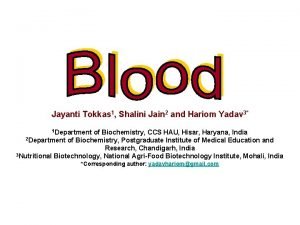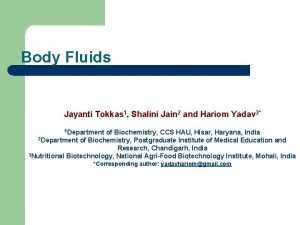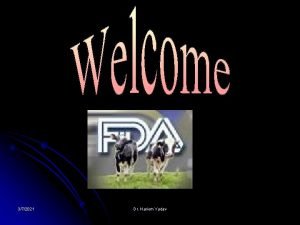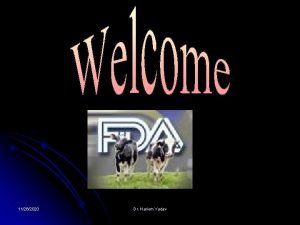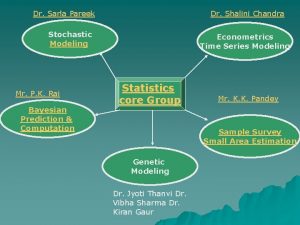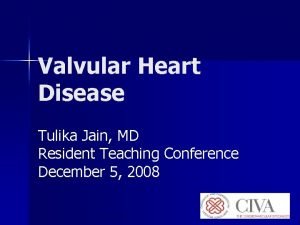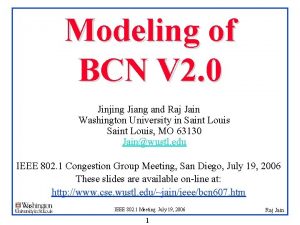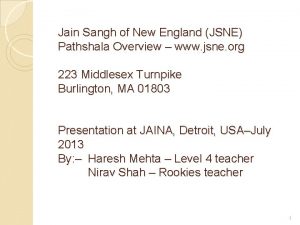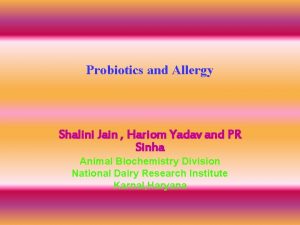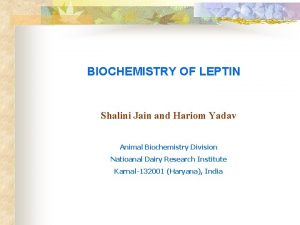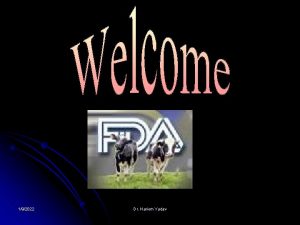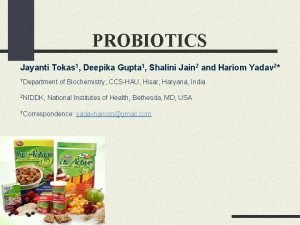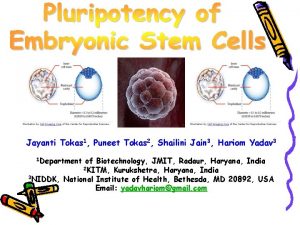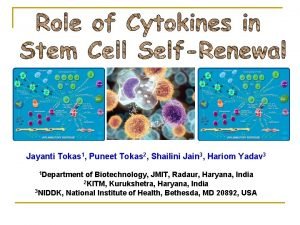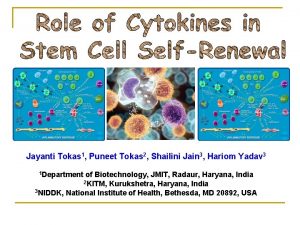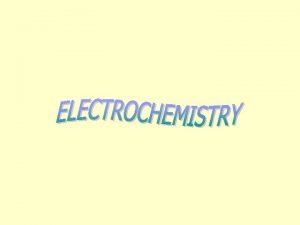Jayanti Tokkas 1 Shalini Jain 2 and Hariom




















- Slides: 20

Jayanti Tokkas 1, Shalini Jain 2 and Hariom Yadav 3* 1 Department of Biochemistry, CCS HAU, Hisar, Haryana, India 2 Department of Biochemistry, Postgraduate Institute of Medical Education and Research, Chandigarh, India 3 Nutritional Biotechnology, National Agri-Food Biotechnology Institute, Mohali, India *Corresponding author: yadavhariom@gmail. com

BLOOD q Connective tissue in fluid form q Fluid of life – carries oxygen from lungs to all parts of body and carbon-di-oxide from all parts of the body to the lungs q Fluid of growth – carries nutritive substances from the digestive system and hormones from endocrine gland to all the tissues. q Fluid of health – protects the body against diseases and get rid of unwanted substances by transporting them into excretory organs like kidney.

Physical Characteristics of Blood • Thicker than water • 8 % of total body weight • Blood volume » 70 m. L/kg of body weight » 5 - 6 liters in males » 4 - 5 liters in females • Temperature - 100. 40 F • p. H - 7. 35 to 7. 45

Blood Functions 1. Respiratory ü Transport O 2 from lungs to tissues ü Transport CO 2 from tissues to lungs 2. Nutrition ü Transport “food” from gut to tissues 3. Excretory ü Transport waste from tissues to kidney (urea, uric acid) 4. Protective ü White blood cells , antibodies, antitoxins.

Blood Functions 5. Regulatory üregulate body temperature ü regulate p. H through buffers ü coolant properties of water ü vasodilatation of surface vessels dump heat ü regulate water content of cells by interactions with dissolved ions and proteins 6. Body Temperature ü Water- high heat capacity, thermal conductivity, heat of vaporization ü Typical heat generation is 3000 kcal/day

Blood composition v Suspension of cells in plasma (carrier fluid) 45% Cells 55% Plasma v Cells Red cells (erythrocytes) 5 x 106/m. L White cells (leukocytes) 7 x 103/m. L Platelets (thrombocytes) 3 x 105/m. L 99% < 1%

Blood composition

Blood Plasma • Straw colored clear liquid • Contains 90% water • 7% plasma proteins Ø created in liver Ø confined to bloodstream Ø albumin Ø maintain blood osmotic pressure Ø immunoglobulins Ø antibodies bind to foreign substances called antigens Ø form antigen-antibody complexes Ø fibrinogen Ø for clotting • 2% other substances Ø Nutrients, electrolytes, gases, hormones, waste products

Functions of plasma proteins 1. Coagulation of blood – Fibrinogen to fibrin 2. Defense mechanism of blood – Immunoglobulins 3. Transport mechanism – α Albumin, β globulin transport hormones, gases, enzymes, etc. 4. Maintenance of osmotic pressure in blood 5. Acid-base balance 6. Provides viscosity to blood 7. Provides suspension stability of RBC 8. Reserve proteins

Formed Elements of Blood • Red blood cells (R. B. C. ) • White blood cells (W. B. C. ) q granular leukocytes q neutrophils q eosinophils q basophils q agranular leukocytes q lymphocytes - T cells, B cells, natural killer cells (N. K. C) q monocytes • Platelets (special cell fragments)

Functions of RBC 1. Transport oxygen from lungs to the tissues (oxyhemoglobin). 2. Transport carbon-di-oxide from tissues to lungs (carboxyhemoglobin) 3. Hemoglobin acts as a buffer and regulates the hydrogen ion concentration (acid base balance) 4. Carry the blood group antigens and Rh factor

Functions of neutrophils 1. First line of organisms. defence against invading micro- 2. Powerful and effective killer machine – contains enzymes like protease, elastase, metalloproteinase, NADPH oxidase; antibody like substances called defensins. Defensins – antimicrobial peptides active against bacteria and fungi. 3. Secrete Platelet Aggregation Factor (PAF) – accelerates the aggregation of platelet during injury to the blood vessels

Functions of eosinophils Secrete lethal substances at the time of exposure to foreign proteins/parasites 1. Eosinophill peroxidase – detroy worms, bacteria and tumor cells. 2. Major basic protein – damage parasites 3. Eosinophill cationic protein (ECP)- destroys helminths. 4. Eosinophill derived neurotoxin – destroys nerve fibres (myelinated nerve fibres)

Functions of basophils Basophill granules release some important substances like – 1. Histamine – Acute hypersensitivity reaction- vascular changes, increase capillary permeability 2. Heparin – prevents intravascular blood clotting 3. Hyaluronic acid – necessary for deposition of ground substances in basement membrane 4. Proteases – exaggerate inflammation • Basophill have Ig. E receptor – hypersensitivity reaction

Functions of Platelets 1. Blood clotting 2. Clot retraction 3. Defence mechanism 4. Homeostasis 5. Repair and rupture of blood vessel

Gas transport • Continuous interchange of CO 2 and O 2 between lungs and tissues. • Oxygen – • major e- acceptor • indispensable for ATP production. • CO 2 • major by product of energy metabolism

p. H maintenance • Oxygen release helps to maintain p. H in tissues • Lungs: – HHb + O 2 = Hb. O 2 + H+ • Tissues: – CO 2 forms proton and bicarbonate – Proton is bound to Hb, when O 2 is released – Bicarbonate leaves RBC • Cl- / HCO 3 - interchange - Hamburger effect

Hb • Higher ability of Hb to release O 2 but lower ability to bind O 2 - Right shift • Useful at site of O 2 release (tissues) higher temperature • higher 2, 3 BPG level • lower p. H (Bohr effect) •

CO 2 transport 1. Bicarbonate formation within RBC and Cl interchange 2. CO 2 dissolved in blood plasma 3. Carbaminohemoglobin formation

 Tokkas
Tokkas Tokkas
Tokkas Kristu jayanti college tcs
Kristu jayanti college tcs Hariom l. yadav
Hariom l. yadav Hariom l. yadav
Hariom l. yadav Hariom l. yadav
Hariom l. yadav Shalini kurapati
Shalini kurapati Dr shalini chandra lucknow
Dr shalini chandra lucknow Right sided vs left sided murmurs
Right sided vs left sided murmurs Sanjay jain nus
Sanjay jain nus Jain bcn
Jain bcn Dr piyush jain rml hospital
Dr piyush jain rml hospital Cseo microsoft
Cseo microsoft Anu jain
Anu jain Dr salil jain
Dr salil jain Jain center of northern california
Jain center of northern california Prateek jain
Prateek jain Jain society of central florida
Jain society of central florida Richa jain md
Richa jain md Pramod jain lunawat
Pramod jain lunawat Jsne
Jsne
